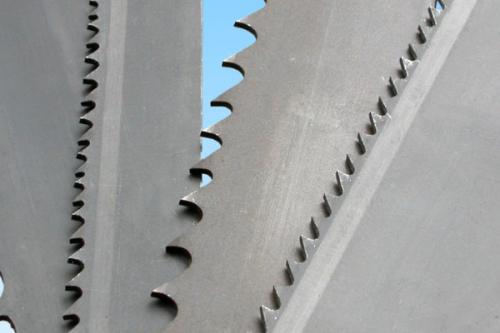There are several industries that utilize high-strength metals like steel throughout their daily operations. Like many other high-strength metals, organizations will utilize steel for its distinct characteristics such as high durability, tensile strength, and yield strength.
Although steel is great for many applications, it often undergoes several different processes before it reaches the final user. Many steel products come in industry standard sizes, but some customers will require certain specifications for their products that better align with their intended application. One way of satisfying the customer's specifications is to cut the steel to length by using an industrial horizontal band saw.
What is a horizontal band saw?
Horizontal band saws have a long, toothed blade that runs parallel to the floor. The band saws can be operated manually, or they can also be automated via a CNC machine for high-volume cutting purposes. The angle of the toothed blade makes the horizontal band saw ideal for cutting longer steel products like tubing, pipe, structural shapes, and bar.
Some of the key advantages an organization using a horizontal band saw may include:
- Precise cutting
- Faster cuts
- Ease of use
- Minimization of material waste
How to Use a Horizontal Band Saw
A horizontal band saw is an essential tool in the steel industry, used for precision cutting of metal stock, pipes, and bars. Understanding how to operate this machine safely and effectively can improve efficiency and ensure high-quality cuts. Below is a step-by-step guide on how to use a horizontal band saw for steel cutting.
1. Understanding the Horizontal Band Saw
A horizontal band saw consists of a continuous blade running between two wheels, designed to cut through metal with precision. Unlike vertical band saws, which require manual movement of the material, horizontal band saws have a downward-moving blade that allows for automatic cutting.
2. Safety Precautions
Before learning how to use a horizontal band saw, always adhere to the following safety measures:
-
Wear appropriate personal protective equipment (PPE), including gloves, safety goggles, and hearing protection.
-
Ensure the work area is clean and free from obstructions.
-
Check the saw blade for any signs of wear or damage.
-
Securely clamp the material to prevent movement during cutting.
-
Use coolant or lubricant to reduce heat and blade wear.
-
Never place hands near the cutting blade while the machine is operating.
3. Setting Up the Machine
a. Selecting the Right Blade
-
Choose a blade with the appropriate tooth per inch (TPI) rating based on the material thickness.
-
Use bi-metal or carbide-tipped blades for cutting steel efficiently.
b. Adjusting Blade Tension and Speed
-
Ensure the blade tension is set according to manufacturer specifications.
-
Adjust the cutting speed based on the hardness of the steel. Higher speeds work well for softer metals, while lower speeds are better for harder steels.
4. Cutting Process
a. Positioning the Workpiece
-
Secure the steel stock in the machine's vise.
-
Align the cut line with the blade to ensure precision.
b. Starting the Cut
-
Turn on the machine and allow it to reach the desired speed.
-
Slowly lower the blade onto the workpiece, letting the saw do the work without excessive force.
c. Monitoring the Cut
-
Keep an eye on the cutting process to ensure a straight and smooth cut.
-
Apply coolant to prevent overheating and extend blade life.
-
Listen for unusual noises, which could indicate a dull blade or incorrect feed rate.
d. Completing the Cut
-
Once the cut is complete, turn off the saw and wait for the blade to stop completely.
-
Remove the finished piece and check for accuracy.
5. Maintenance and Troubleshooting
Regular maintenance ensures the longevity and efficiency of your horizontal band saw.
-
Clean the machine and remove metal shavings after use.
-
Inspect the blade for dullness or damage and replace if necessary.
-
Lubricate moving parts to prevent wear and tear.
-
Check blade alignment periodically to ensure accurate cuts.
Conclusion
How to use a horizontal band saw in the steel industry requires attention to detail, safety precautions, and proper machine maintenance. By following these steps, operators can achieve precise and efficient cuts, maximizing productivity while extending the lifespan of the equipment.
Precision cutting is just one of the many special capabilities that ECONSTEEL offers its customers. Be sure to explore the rest of the website or speak to one of our knowledgeable sales reps to find out what else we can do to meet your specifications!

